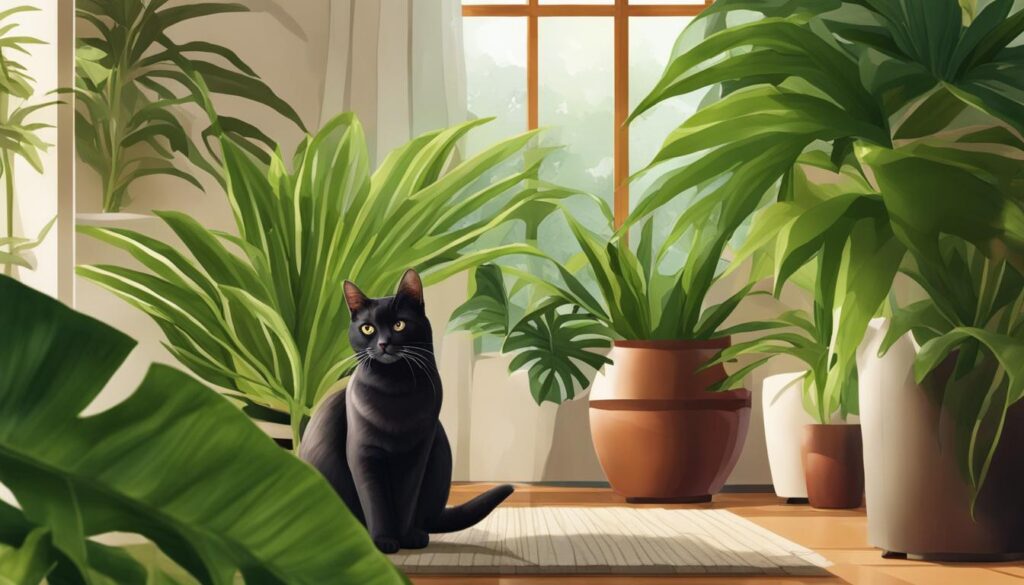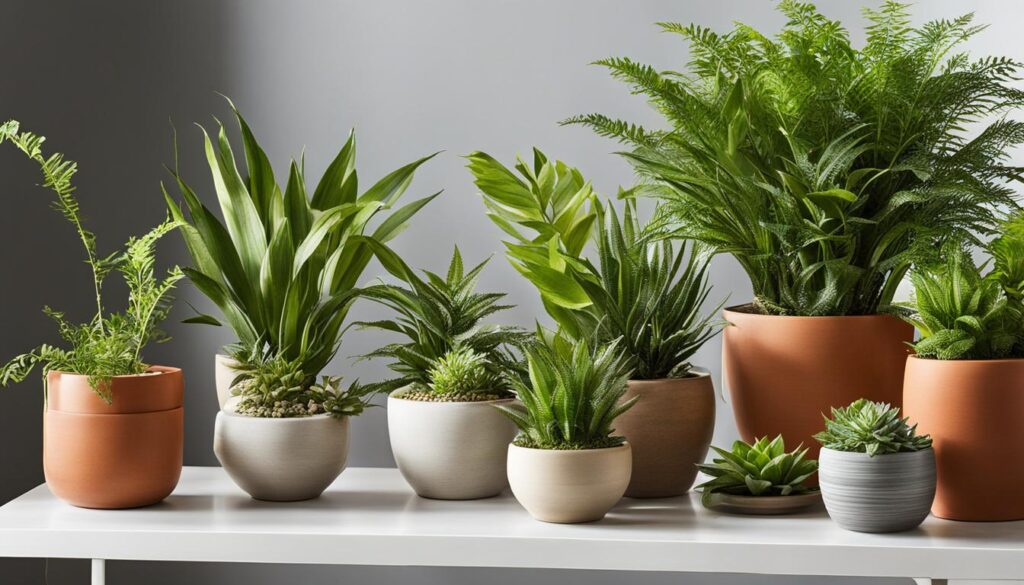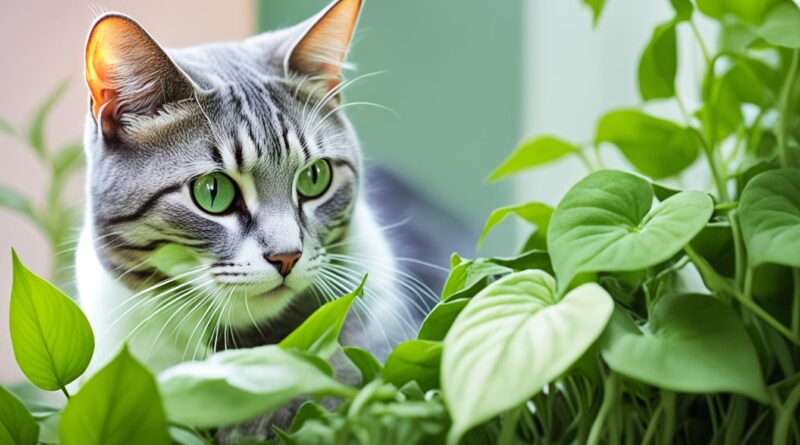Pothos Plant Safety: Is Pothos Toxic to Cats?
If you are a cat owner and a plant enthusiast, it is essential to be aware of the potential dangers that certain houseplants can pose to your feline friend. One popular indoor plant, the pothos plant, may be aesthetically pleasing and easy to care for, but it is important to understand its impact on cat safety.
Pothos plants, scientifically known as Epipremnum aureum, are toxic to cats if ingested. These plants contain calcium oxalate crystals, which can result in oral irritation, excessive drooling, vomiting, and difficulty swallowing for our furry companions. Being mindful of the harmful effects of pothos plants is crucial in creating a cat-friendly environment.
Key Takeaways:
- Pothos plants are toxic to cats if ingested.
- They contain calcium oxalate crystals that can cause oral irritation and other symptoms in cats.
- Monitoring your cat for any signs of pothos toxicity is important.
- Seek veterinary care immediately if your cat displays symptoms of pothos plant poisoning.
- There are cat-friendly houseplant alternatives to consider for a safe and enjoyable environment.
Understanding Pothos Plant Toxicity
According to the ASPCA, all varieties of pothos plants are considered toxic to cats. The presence of calcium oxalate crystals in the plant’s leaves and stems leads to oral irritation and discomfort for cats who ingest it. Symptoms of pothos toxicity in cats include pawing at the mouth, mouth irritation, vomiting, loss of appetite, abnormal drooling, and difficulty swallowing. While pothos plants may not be fatal to cats, they can cause significant discomfort and should be avoided in cat-friendly households.
If you suspect that your cat has ingested part of a pothos plant, it is important to be vigilant for symptoms of poisoning. Pawing at the mouth, mouth irritation, vomiting, loss of appetite, abnormal drooling, and difficulty swallowing are common signs of pothos plant poisoning in cats. If these symptoms are present, it is crucial to seek veterinary care immediately. Treatment for pothos plant poisoning may include thorough oral cleansing, stomach washing, pain relief, anti-allergy medication, and additional treatment depending on the severity of the cat’s reaction. Prompt treatment can lead to a full recovery for cats affected by pothos plant toxicity.
“All varieties of pothos plants are considered toxic to cats. The presence of calcium oxalate crystals in the plant’s leaves and stems leads to oral irritation and discomfort for cats who ingest it.” – ASPCA
The Symptoms of Pothos Toxicity in Cats:
- Pawing at the mouth
- Mouth irritation
- Vomiting
- Loss of appetite
- Abnormal drooling
- Difficulty swallowing
While pothos plants may add a touch of greenery to your home, they can pose a significant danger to your feline friends. It is important to be aware of the risks and take necessary precautions to ensure a safe and pet-friendly environment. In the next section, we will explore ways to keep your cat safe from pothos plants and discover alternative options for cat-friendly indoor plants.
Keeping Your Cat Safe from Pothos Plants
To ensure the safety of your beloved feline companion, it is important to take precautions and keep pothos plants out of their reach. Here are some tips to help you create a cat-friendly environment:
- Display pothos plants in hanging planters: Hanging planters can prevent cats from accessing the plants and nibbling on their leaves. This simple step can go a long way in keeping your cat safe.
- Regularly trim the vines: By regularly trimming the vines and keeping them away from the ground, you can reduce the chances of cats playing with or ingesting the plant.
- Provide alternative stimulation: Cats are naturally curious and love to explore their surroundings. To redirect their attention away from houseplants, provide them with scratching posts, cat trees, and dangling toys. These playful distractions can keep your cat engaged and help prevent them from taking an interest in your plants.
- Grow cat-safe plants indoors: To satisfy your cat’s desire to munch on greens, consider growing cat-safe plants like cat grass or catnip indoors. These plants provide a safe and enjoyable alternative for your cat to satisfy their natural instincts.
By implementing these measures, you can create a cat-friendly space that ensures the well-being and safety of your feline friend.

Example Table:
| Plant Name | Scientific Name | Safe for Cats |
|---|---|---|
| Spider Plant | Chlorophytum comosum | Yes |
| African Violet | Saintpaulia spp. | Yes |
| Areca Palm | Dypsis lutescens | Yes |
| Money Plant | Epipremnum aureum | Yes |
| Calathea | Calathea spp. | Yes |
Key Takeaways:
By taking simple precautions such as displaying pothos plants in hanging planters, providing alternative stimulation for your cat, and growing cat-safe plants indoors, you can create a cat-friendly and safe environment.
Symptoms and Treatment for Pothos Plant Poisoning in Cats
If you suspect that your cat has ingested part of a pothos plant, it is important to be vigilant for symptoms of poisoning. Common signs of pothos plant poisoning in cats include:
- Pawing at the mouth
- Mouth irritation
- Vomiting
- Loss of appetite
- Abnormal drooling
- Difficulty swallowing
If you notice any of these symptoms in your cat after contact with a pothos plant, it is crucial to seek veterinary care immediately. Early intervention can significantly increase the chances of a full recovery.
Treatment for pothos plant poisoning in cats may include:
- Thorough oral cleansing to remove any plant residue
- Stomach washing to eliminate any remaining toxin
- Pain relief medication to alleviate discomfort
- Anti-allergy medication to reduce inflammation and allergic reactions
- Additional treatment as necessary, depending on the severity of the cat’s reaction
It is important to consult with a veterinarian for proper diagnosis and treatment. Do not attempt to induce vomiting or administer any medications without professional guidance.
Alternatives to Pothos Plants for Cat-Friendly Homes
While pothos plants are not safe for cats, there are plenty of other houseplant options that are cat-friendly. Here are some beautiful and low-maintenance plants that you can consider:
- Peperomia
- Christmas cactus
- Boston fern
- Prayer plant
These plants not only provide a lush and decorative element to your home but also ensure the safety of your feline friend by being non-toxic to cats. They are perfect choices for cat-friendly houseplants that will add a touch of greenery to your space without compromising your pet’s health.
For more options and to ensure the safety of all plants in a cat-friendly environment, it is recommended to refer to the ASPCA’s toxic and non-toxic plant list. This comprehensive resource can help you make informed decisions and create a safe and enjoyable environment for both you and your cat.
Remember, when choosing cat-friendly houseplants, opt for plants that are safe for cats and provide an enriching and aesthetically pleasing environment for everyone to enjoy.

Cat-Friendly Houseplants: Benefits for You and Your Feline Companion
Having cat-friendly houseplants offers several benefits. Not only do they enhance the overall aesthetic appeal of your home, but they also provide mental stimulation and a sense of tranquility for your furry friend. Indoor plants can help create a calming atmosphere and improve air quality, making your space more inviting and relaxing for both you and your cat.
“Cat-friendly houseplants add life and vitality to any space, making it more vibrant and cozy. They provide a stimulating environment for your cat while ensuring their safety and well-being.”
Additionally, incorporating cat-friendly houseplants into your home can help satisfy your cat’s natural instinct to explore and interact with nature. By providing a cat-friendly environment that includes safe plants for cats, you can promote physical and mental well-being, reduce anxiety, and prevent destructive behaviors.
Importance of Cat-Proofing Your Home
Cat-proofing your home plays a vital role in ensuring the safety and well-being of your feline companion. Cats are naturally curious creatures, and their inquisitive nature often leads them to explore and potentially ingest harmful substances or plants. As a responsible pet owner, it is crucial to take proactive measures to protect your cat from the dangers that houseplants can pose.
Avoiding toxic houseplants: One of the key aspects of cat-proofing your home is being aware of the dangers that certain houseplants can pose to cats. While many plants can enhance the aesthetic appeal of your home, some can pose a significant risk to your furry friend’s health.
“Regular monitoring and prompt veterinary care are essential if any signs of poisoning occur.”
Securing potentially dangerous items: It’s not just plants that can be hazardous to cats. Other household items such as cleaning agents, medications, and small objects can also pose a threat. Ensuring that these items are safely stored and out of your cat’s reach minimizes the risk of accidental ingestion.
Providing alternative stimulation: Cats are natural hunters and have a strong instinct to explore and play. By providing them with plenty of engaging toys, scratching posts, and climbing shelves, you can divert their attention away from houseplants. This helps satisfy their natural instincts and reduce their curiosity towards potentially harmful vegetation.
Creating a safe environment: It’s essential to create a safe and enriching environment that promotes your cat’s overall health and happiness. This includes setting up designated areas for play and relaxation, arranging furniture to minimize potential hazards, and ensuring the availability of fresh water and a healthy diet.
Regular veterinary check-ups: Along with cat-proofing your home, regular visits to the veterinarian are equally important. Routine check-ups will help identify any potential health issues early on and ensure that your cat receives the necessary preventive care.
By incorporating these cat-proofing measures into your home, you can create a safe haven for your feline companion. It’s essential to remember that the well-being of your cat is a shared responsibility, and taking these steps helps protect them from the dangers of houseplants and other potential hazards.
Conclusion
Cat owners should prioritize their pet’s safety by avoiding pothos plants in their homes. These popular indoor plants are toxic to cats due to the presence of calcium oxalate crystals. To ensure the well-being of feline friends, it is crucial to understand the symptoms and dangers of pothos plant toxicity.
Creating a cat-proof environment is essential for protecting cats from potential plant-related hazards. By keeping pothos plants out of their reach, using hanging planters, and providing alternative forms of stimulation, owners can redirect their cat’s attention away from houseplants.
Regular monitoring of cats for any signs of poisoning, such as pawing at the mouth, vomiting, or abnormal drooling, is important. If these symptoms occur, immediate veterinary care should be sought. In addition, cat owners can explore cat-friendly houseplants as safe alternatives to pothos plants.
FAQ
Is pothos toxic to cats?
Yes, pothos plants are toxic to cats if ingested.
What makes pothos plants toxic to cats?
Pothos plants contain calcium oxalate crystals, which can cause oral irritation and other symptoms in cats.
What are the symptoms of pothos toxicity in cats?
Symptoms may include pawing at the mouth, mouth irritation, vomiting, loss of appetite, drooling, and difficulty swallowing.
How can I protect my cat from pothos plants?
Keep pothos plants out of your cat’s reach, consider hanging planters, and provide alternative forms of stimulation.
What should I do if my cat ingests part of a pothos plant?
Keep a close eye on your cat for symptoms and seek veterinary care immediately if necessary.
Are there alternative plants that are safe for cats?
Yes, there are many cat-friendly houseplants, such as peperomia, Christmas cactus, Boston fern, and prayer plant.
What other precautions should I take to keep my cat safe?
Aside from avoiding toxic plants, secure other potentially dangerous items and chemicals in your home and provide plenty of stimulation for your cat.


